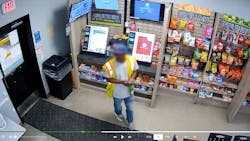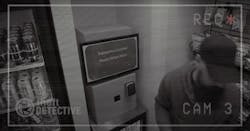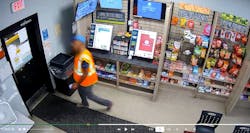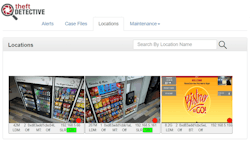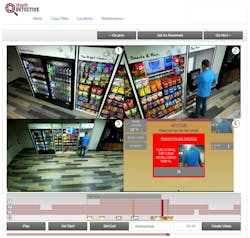A technology-driven approach to mitigating micro market theft
According to the 2023 Automatic Merchandiser State of the Industry Report published in June, more than 42,000 active micro markets are being operated in the United States. Since the very first micro market was placed over a decade ago, product theft — also known as “shrink” — has been an active topic of conversation, and a bit of mystery. What is the real shrink level in micro markets, and how can operators mitigate it in a cost-effective way?
In that same study, operators were asked to identify their average level of micro market theft. While 3% optimistically said they were at a 0% shrink, the vast majority fell into the 3% to 7% range.
Using AI to control shrink
One might conclude from the report that the shrink situation isn’t that bad and that, generally speaking, operators have it covered. Bridger Keally, sales manager of Panoptyc, isn’t so sure. Panoptyc is one of three micro market security providers in the industry that are taking a high tech approach — often using AI — to keep micro market shrink levels under control.
“Operators come to us for a few different reasons. The most prominent issue is that they're struggling with theft, obviously. When you've got a self-checkout, it's an inherent risk. We have seen the industry average at around 6% across the board recently, and it's obviously tough seeing that profit slip away,” said Keally. “In many situations, that number is much higher.”
“Second reason is labor. The operators are super busy working on growing their business, managing accounts, all that stuff. And it's frustrating when they have people sitting and reviewing footage for hours, managing shrink instead of working on growing the business. And the third part is the outdated camera systems that have been standard for quite a while. Just dealing with those DVR swaps is a pain. Our system was built around addressing those three core pain points that most operators share,” he added.
Keally said Panoptyc offers a variety of options for operators to attack micro market theft with different levels of service. “On a high level, there are two main features. One is theft detection. That is software that looks for a variety of suspicious behaviors that take place in a market,” he said.
Panoptyc also offers features that allow operators to view their market, evaluate driver performance and assess the need for service at a location.
Keally pointed out that while their technology is great at reducing shrinkage, communication with the client is critically important, especially early on. He encourages operators to have a conversation upfront, explaining that while you do not expect to have a theft problem, you have invested in a system that can identify suspicious activity. Operators should assure clients that they want to work with them to resolve issues when they happen, which will keep prices low, keep the shelves stocked and provide a better experience for everyone.
He noted that getting a contract upfront that addresses how theft is going to be dealt with — either discipline, a conversation or reimbursement — is important. “The biggest key to success is awareness. If the customer is willing to bring awareness to the market — that it's not okay to steal and that it's going to be monitored — that's where you're going to see ROI with the system,” Keally said, adding that it must be a partnership between the operator and the client. “If the shrink goes above a certain level, the client has to be willing to participate in the loss. That needs to be in the contract.”
AI helps put the ‘attendant’ in unattended retail
ProWatch Solutions is another company that is taking an AI-driven approach to micro market theft mitigation. Company founder Mark Kronenberg has a long familial and personal relationship with the convenience services industry.
“My family actually started in vending in the 1930s. I grew up in vending. My grandparents were both on the board of NAMA. My grandmother was the first woman on a NAMA board,” he said. “In the early 80s, I developed software for our own operation, which had vending and industrial catering. My father and I started CompuVend Systems and had that for 32 years before we sold it to Cantaloupe.”
Kronenberg was acting as an industry consultant when he began to recognize that operators were struggling with micro market theft. It was challenging and time-consuming — if they even had the time to deal with theft. Kronenberg began developing a technology-based solution he called ARMS - Automated Retail Management System, about three years ago. “We did it by getting a lot of input from both large and small market operators. We did a proof-of-concept, asked them for feedback on it and then moved into the pilot phase. We eventually launched several months ago into the marketplace,” he explained.
“In a nutshell, we're using surveillance video and applying AI and other analytics to identify theft and other lost sales opportunities while providing the operator an easy-to-use, actionable format that they can access to promote a good conversation with their customer,” Kronenberg said. “Our goal is to have controls for theft as well as lost sales opportunities.”
Kronenberg said the company’s basic vision is to put the attendant in unattended. “If I could be a fly on the wall to look and see what's going on in a market and identify certain events or actions that could help improve the market, we want to use technology and artificial intelligence to identify those to help the market operator.”
“I know what it's like to actually make money in this business as an operator. I want to make sure that operators have the resources they need to be successful in the micro market business without having to spend lots of money to do it,” Kronenberg said.
“It is clear that we have a solution for operators, and it has gained a lot of interest for us in the marketplace right now,” Hebert added.
Identify suspicious behavior
Another player in the theft mitigation business, Theft Detective, is not a company, but a product that has been on a journey of its own since 2017. Kevin Galaida is the project coordinator for Theft Detective and senior business development manager for GlobalConnect, which now owns the product after purchasing Breakroom Provisions in 2024.
“We actually started working with Theft Detective around the same time that Panoptyc was making a name for themselves,” said Galaida, who explained that Theft Detective is both a software system and a camera system that was developed by his team at Breakroom Provisions.
“The hardware that we use for Theft Detective is proprietary hardware built from scratch specifically for this purpose to run on our software. Each camera is a single-board computer with a camera module, onboard storage, and then the majority of what happens with Theft Detective, especially when a user is working with it, is all cloud-based,” he said, noting that the system is well-suited for AI down the line.
“The whole idea here is to give your client everything they need at their fingertips, and the really nice thing about Theft Detective, the way we designed it, with just a couple clicks, the operator can send a link to a case file video to their client without having to worry about moving large video files around,” he said. “We wanted to optimize that whole process, make it more efficient and ultimately, it's about preventing those losses due to theft.”
About the Author

Bob Tullio
Bob Tullio is a content specialist, speaker, sales trainer, consultant and contributing editor of Automatic Merchandiser and VendingMarketWatch.com. He advises entrepreneurs on how to build a successful business from the ground up. He specializes in helping suppliers connect with operators in the convenience services industry — coffee service, vending, micro markets and pantry service specifically. He can be reached at 818-261-1758 and [email protected]. Tullio welcomes your feedback.
Subscribe to Automatic Merchandiser’s new podcast, Vending & OCS Nation, which Tullio hosts. Each episode is designed to make your business more profitable.
